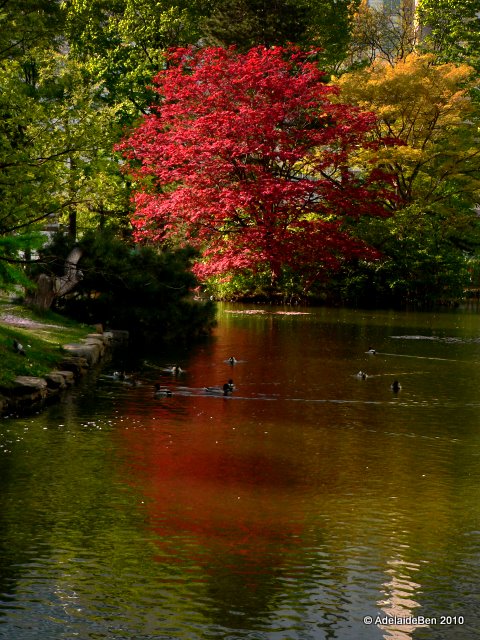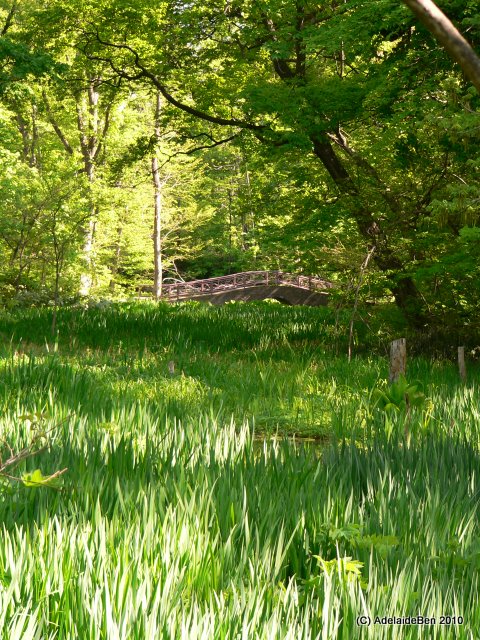13th May, 2008 - Spring time in Sapporo is beautiful, and full of life. Which is a good thing, because Spring is relatively short. After a long week of being at home relaxing, we ventured forth again with L-kun. This time we wanted to go into the city and visit the
Hokkaido Botanic Gardens (
Hokkaidō Daigaku Shokubutsuen).
View Larger Map
And if you're looking at the maps, check out StreetView... as they've implemented a great idea here... a higher than normal definition walk around the garden paths. This is a great feature.
|
Photo taken from Google Streetview... or is that Parkview |
These gardens are actually formally part of the Hokkaido University, and as such they are as much about learning as they are about enjoying nature. They were established in 1886, and are the second oldest botanic gardens in Japan.... but not quite as old as the
Botanic Gardens back home in Adelaide which pipped them by only 30 years or so. Still, the city of Sapporo was effectively born only in 1868, so it is very much an integrated part of the city.
There are a number of different parts to the gardens, each section having it's own ambiance. The first section that we entered was brilliantly colourful, with lots of flowers in full bloom.

Now, I've said it before, and I'll say it again. A green thumb is definitely not part of my anatomy... so expect a lot of long uncomfortable pauses if you want to ask me specific botanic questions.
It may not be surprising to you that one of my favourite flowers is actually that from the Rhododendron... the bright red flowers may be a little on intense side, but there's something very unconditional about the flowers. Our climate isn't so good for them back in Adelaide, but one of my favourite spots is the
Rhododendron Valley in the Mount Lofty Botanic Gardens.
I sometimes wished that I had half a clue when it came to plants and gardening... but I don't think Rhododendron's do well in the hot dry climate of the Adelaide plains. The soil almost certainly too alkaline for these to grow well without a whole heap of conditioning.
There is a good use of water in various parts of the gardens. Never enough to dominate the experience, but just enough to add a sense of stillness.
And with it you can just relax and let the tension flow out of you as you look at the slow-motion explosion of colours and textures of these flowering plants.
There is quite a large area within the botanic gardens that looks... well... like a forest. In fact, it looks like a perfect place to understand what the natural forests had to offer, without having to go out and find a native forest to go exploring in... as you never know what kind of strange creatures you might come across inside such a forest...
Once again, the use of water, and in this case the grasses that grow by the waterways is quite beautiful. The bridge in the distance just adds to that feeling like you may have just stepped into a painting.
There's also wide open grassed areas within the gardens made from Kentucky bluegrass. Now that doesn't really have a Japanese ring to it.
Lilacs are possibly the most quintessential flora for Sapporo - which is interesting as they're not native at all. Lilacs were brought over from the USA by the Christian educator Sarah Clara Smith in 1890, from which point they spread quite extensively. Whilst the Lilac has now become closely associated with Sapporo (which holds a Lilac Festival later in May each year), it was only selected by popular vote as the symbolic tree for the city in 1960. Actually, T-chan has a slightly tangential association with the Lilac, as she attended the school Hokusei Gakuen Girl's High School which Smith had established along with her Lilacs. During the war, the trees were cut down (not sure if we should read anything into this) - but they sprouted forth once more after the war was over. And so the legend was born.

And whilst the sakura were well and truly past their prime in Maruyama, in the Botanic Gardens they were still going strong... This variety certainly was vibrant... but completely overpowered by the most beautiful blossom of them all, my gorgeous wife T-chan.
Yet another homework piece.... ah, it's going to be a busy week.
And all the time, the ever present Karasu (or crow) looks on... it's haunting (and let's be honest, annoying) cry echoing across the Park. Actually, this picture might suggest only a single, lonely Karasu... oh no.. there were 10's, if not 100's of them... well at least 10. Karasu are the plague of many Japanese cities for the reason that they are scavengers, and will scavenge in the neighbourhood refuse which is typically gathered in a single spot on the roadside awaiting collection. If the rubbish isn't properly covered, good ol' Karasu will find a way in and before you know it, the rubbish will have found a way out. I think they are pretty well universally despised within Sapporo at least.

Once again, the use of water in the garden is subtle and yet powerful. The elevated path winds through a shallow lake filled with all manner of different water plants. At least we think it was shallow, as we were pushing our stroller with a now sleeping L-kun in it. And a good thing to, as the broadleaf plants are known as skunk cabbage... not something I'd like to fall into.
Our experience of the Botanic Gardens was one of pleasant surprise. It's not a particularly showy garden, and in parts looks downright native. However, as a respite from the city (like it's Adelaide counterpart) it makes for a relaxing stroll, not just through the gardens, but also through a slice of Sapporo history.


















































